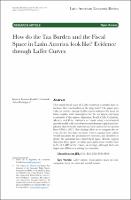How do the tax burden and the fiscal space in Latin America look like? Evidence through laffer curves

Fecha de publicación
2021-11-17Author
Lozano-Espitia, Ignacio
Arias-Rodríguez, Fernando
Formato
application/PDF
URL del recurso
http://hdl.handle.net/11651/4759Idioma
eng
Acceso
Acceso abierto
Compartir
Metadata
Show full item recordAbstract
How much fiscal space do Latin American countries have to increase their tax burdens in the long term? This paper provides an answer through Laffer curves estimates for taxes on labor, capital, and consumption for the six largest emerging economies of the region: Argentina, Brazil, Chile, Colombia, Mexico, and Peru. Estimates are made using a neoclassical growth model with second-generation human capital and employing data from the national accounts system for the period from 1994 to 2017. Our findings allow us to compare the recent effective tax rates on factor returns against those which would maximize the government’s revenues, and therefore to derive the potential tax-related fiscal space. Results suggest that joint fiscal space on labor and capital taxes would reach 6.5% of GDP for the region, on average, although there are important differences among the countries.
Editorial
Centro de Investigación y Docencia Económicas
Derechos
La revista Latin American Economic Review autoriza a poner en acceso abierto de conformidad con las licencias CREATIVE COMMONS, aprobadas por el Consejo Académico Administrativo del CIDE, las cuales establecen los parámetros de difusión de las obras con fines no comerciales. Lo anterior sin perjuicio de los derechos morales que corresponden a los autores.
Tipo
Artículo

